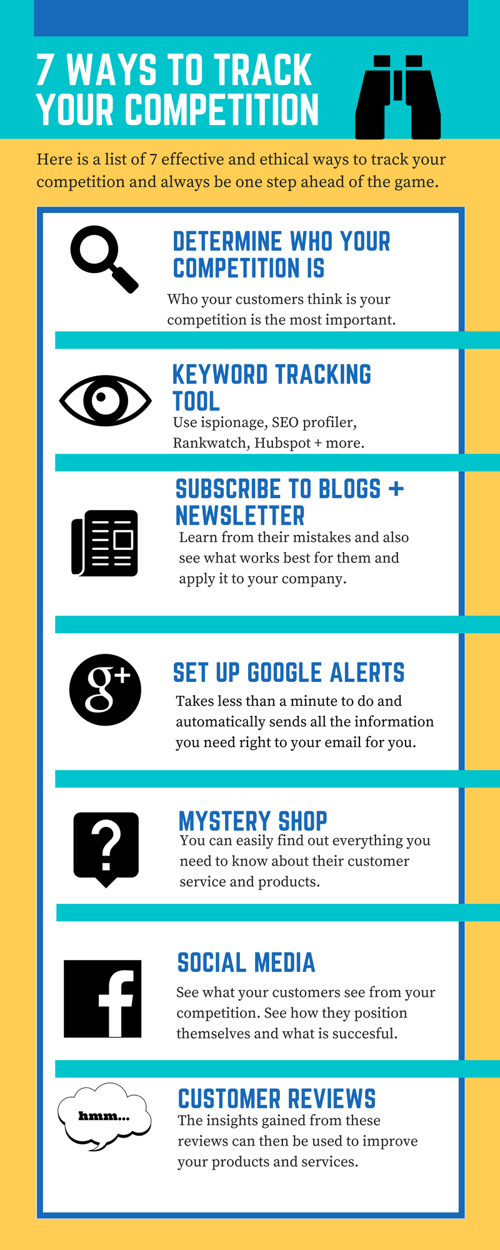Monitoring your competitors' marketing activity is an excellent strategy to maintain a competitive edge. It may seem daunting, but it's actually quite simple.
Here are seven valuable tips to assist you in tracking pricing trends, evaluating enhancements to products or services, and staying informed about changes in their marketing strategies and tactics.
7 Tips to Track Your Competition
Track Your Competitors' Marketing to Maintain a Competitive Edge
1. Determine who your competition actually is
Before you start tracking competitive marketing, it's important to conduct some research to determine which companies should be included on your list. This step may seem obvious, but it can lead to surprising discoveries.
To identify your competitors, consider the following:
- Reach out to your customers and ask them about their perception of your competition.
- Attend industry conferences and events to learn more about other companies in your field.
- Explore online lists or directories where your company is listed and see which other firms are included.
- Conduct a Google search using the same keywords your customers would use to find your company, and see which other companies appear in the search results.
Don't forget to also consider substitute products. For example, if you sell heating oil, it's worthwhile to monitor the marketing practices of natural gas and propane distributors as well.
2. Use a keyword tracking tool to sleuth competitive use of PPC and SEO
The internet is a wealth of information waiting to be discovered. Take advantage of this vast resource to gain insights into your competitors' marketing strategies. With a wide range of tools available, it is now easier than ever to identify which firms are outperforming your company in terms of targeted keywords. By researching the keywords your competitors are bidding on, you can develop your own PPC and SEO strategies to stay one step ahead.
Here are some tools worth checking out that will impress your boss with fresh ideas:
- Ispionage
- SEOprofiler
- RankWatch
- Wincher
3. Subscribe to competitor blogs and newsletters
This is a great idea because you can learn by seeing what works and doesn’t work from them. Track how frequently they post, the type of content they are posting and which tactics generated the most likes or shares. Looking at their content can also spark a new idea that would work great for your company.
4. Set up a Google Alert to notify you when your competitors are mentioned online
This quick and easy step takes less than a minute and provides a wealth of valuable information about your competition.
- It will send reports right to your email inbox
- You can customize how in-depth you want your monitoring to be
- This is great way to keep an even closer eye on your competitors and their PR wins (or losses!).
- The best part: It’s totally free!
Bonus tip: Set up alerts for industry buzzwords that could impact your business.
5. Mystery shop your competition
Mystery shopping is an effective strategy to uncover the strengths and vulnerabilities of your competitors. So gather your team and discreetly assess their performance without drawing attention.
- If it’s a physical store then you or someone they won’t recognize can go in, take a look at their inventory and design.
- Check out their websites. See how easy it is to navigate it and get to the check out. Keep an eye out for the photo quality, types of CTA’s, and how well their sites are mobilized for cell phones.
- See if they use any techniques that your company isn’t.
- See how long it takes them to respond to an email or phone call.
- List their strengths and weaknesses and see how your company compares.
Moreover, consider making a purchase of their product. This will provide valuable insights into their shipping time, packaging quality, and how it compares to your own product.
6. Follow them on social media
Follow your competitors' social media outlets and see how well they control their chatter.
- You can learn about any new products they are launching and see areas of focus.
- Review what the comments are saying and assess their level of engagement.
- Use a tool to help aggregate activity. Hootsuite may be known for easy management of social media marketing, but it also has excellent monitoring capabilities. Buzzsumo lets you analyze the content that performs best for any topic--including your competition!
It's crucial to pay attention to the social media platforms that your competitors are using and determine which ones are the most effective for them. Additionally, be sure to identify any gaps that exist in your industry. You may discover that there is an untapped opportunity on Pinterest or another platform that you can leverage to your advantage.
7. Check customer reviews
Customer reviews, including those of your competitors, provide valuable insights into the preferences and priorities of customers. By analyzing these reviews, you can identify areas where your competitors may be falling short and capitalize on these weaknesses to attract new clients. It is also important to assess how your competitors respond to reviews and handle customer situations.
Downloadable Infographic
7 Ways to Track Your Competition
To get a quick takeaway, feel free to download this infographic, which will provide you with valuable insights and guidance to kickstart your competitive analysis and tracking.







SUBMIT YOUR COMMENT